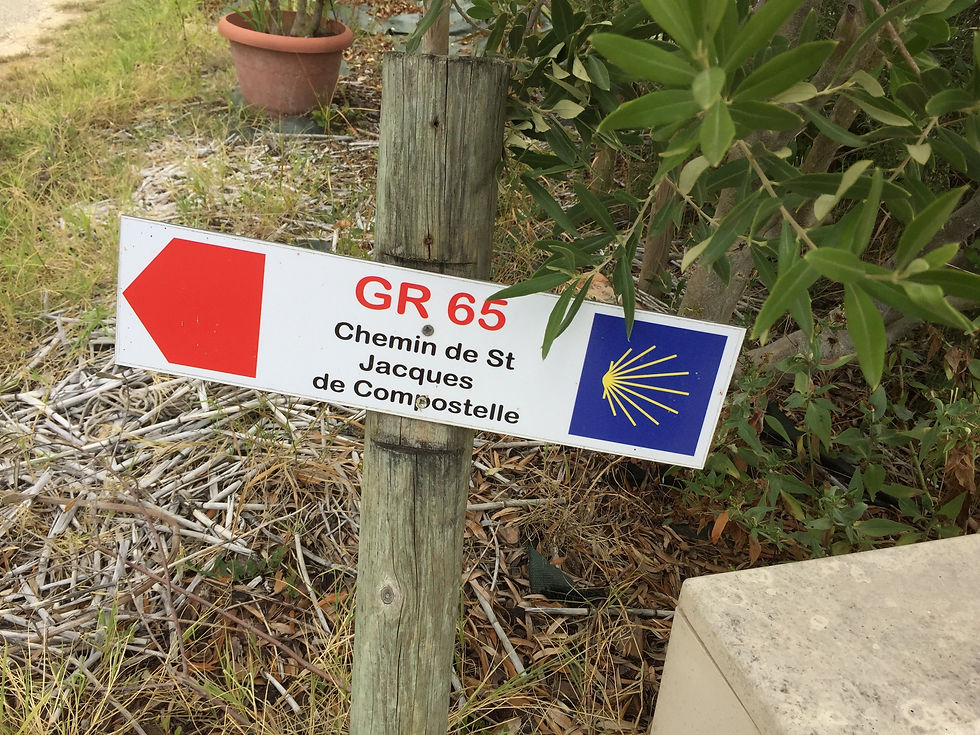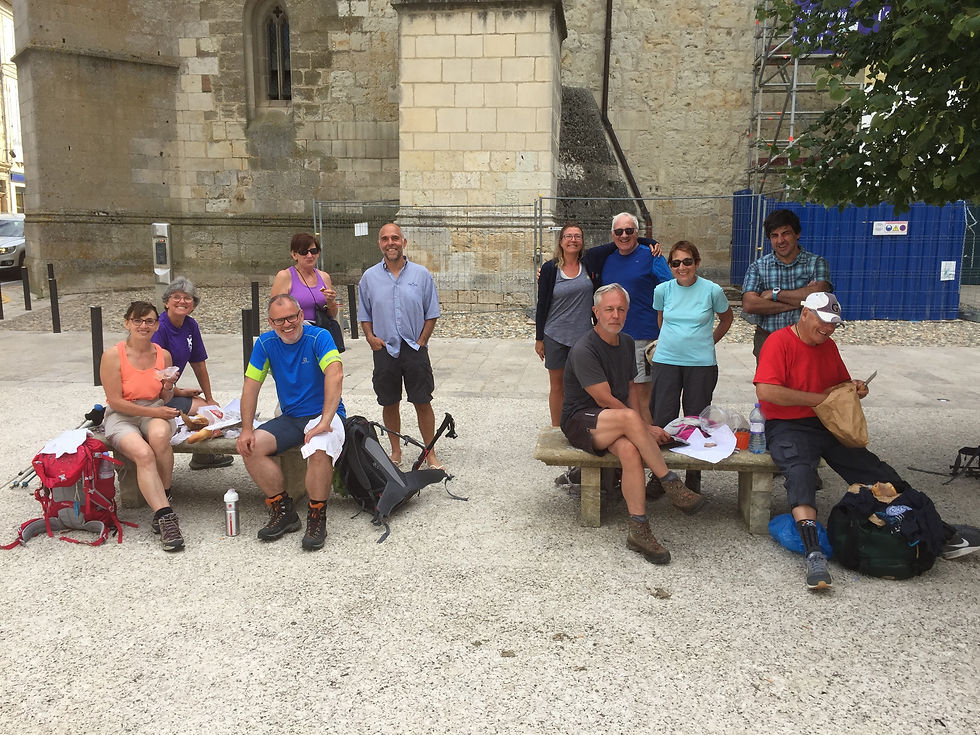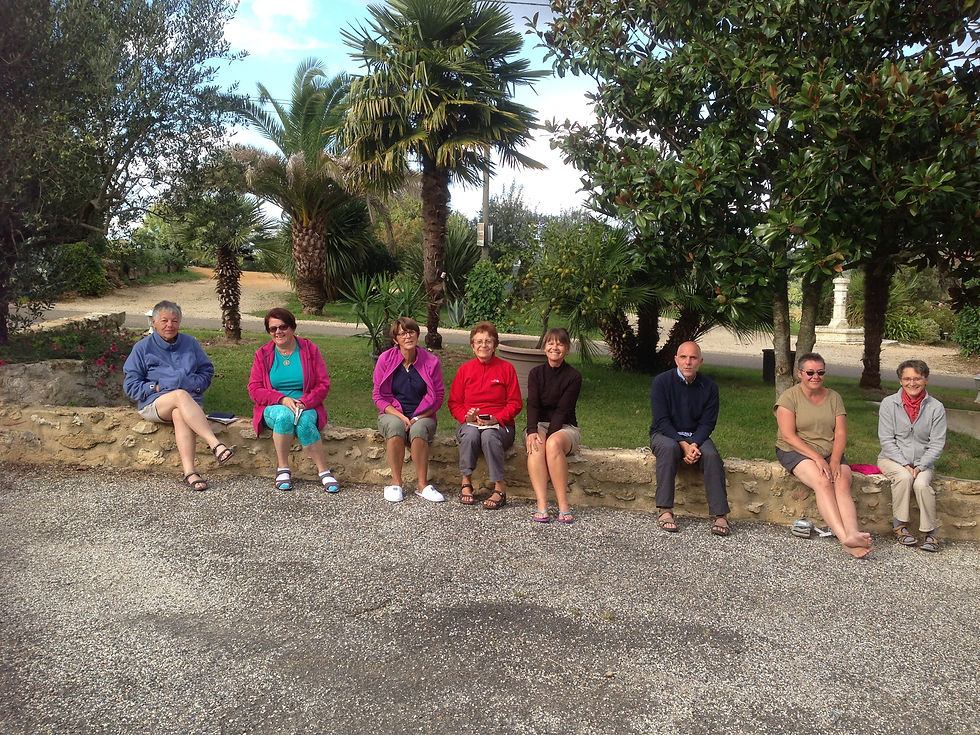Camino Companions Part One
- sophiebreese
- Jan 9, 2018
- 9 min read
One of the things people have asked me about since we got back was who we met on our pilgrimage to Santiago de Compostela, what kind of people they were, and why they were doing it. And since a little bit of time has elapsed it seems right to start a few pieces about my experience on this blog with an article about our Camino Companions.
The first thing to say is that when we were planning our pilgrimage* not once did we consider that we would make lots of friends. We had been too busy thinking about the practical side of it: what we needed to take, what kind of training we should do, where we would stay, how to put our normal lives on hold for 2 months. I had hoped to do some reflection, get fit, find out more about Alex, discover France and Spain, perhaps learn more French and pick up some Spanish. But meeting people? For some reason, I had imagined the two of us walking alone through woods and over mountains, sometimes talking, sometimes thinking. And this totally unrealistic picture was fuelled only by me, because the reading I did in advance made me completely aware that the Camino is a road very much travelled. I am not sure if it was a fantasy of solitude I was looking for, or not.
As it happened, our first four days were quiet. At this point we weren’t actually on the Camino, the Chemin, the Way of St James, or as it is called in France the GR65 (Grande Randonnée 65). Because we were starting from our house, we had to find a way to join the particular branch of the Camino that we had elected to follow (the Chemin du Puy or as it was once called the Via Podiensis). There was one a little nearer to our house but we decided to walk a bit longer off-Way, if you like, to join the first pilgrimage walked in France in the Middle Ages. Alex has an excellent sense of direction, thank goodness, so we only got lost once in those four days and that was down entirely to the non-existence of a sign at a significant moment. It took us 20 minutes to get back on track and that was it, but had we been truly lost there would have been no one to ask, because we met no one else walking on the various GR paths that we followed to get to the Way. Instead it was just us, getting used to walking the kind of distances that we would be walking every day, and adjusting to another way of living, if only for a few months. We stayed in a summer guest house on day one, an AirBnB flat on day two, and a hotel for business people on day three. We passed no other walkers, let alone pilgrims, although when in villages and towns we did encounter others, naturally.

But on Day Four as we neared the beautiful village of Lauzerte, we began to see yellow shell signs on posts or trees, alongside the red and white stripe indicating the route of the GR. We were on the pilgrimage at last. I took a ridiculous number of photographs of these early signs, forgetting that we had another 61 days of them. I think that was always a true giveaway of a Camino Newbie: excessive photographing of yellow scallop shells and yellow arrows. And then we arrived in our first auberge for pilgrims. We were greeted by a rather surprising hug from Marie, the host, followed by an insistence that we sat down and had a glass of mint syrup (something provided by most French auberges, and a wonderful idea to reinstall lost sugars). That night we met our first fellow pilgrims**: a brother and his two sisters, a woman in her seventies with a small backpack and an absolute determination to do the whole thing, and a stockier man with whom she was now travelling although they were not together and had both left respective spouses behind. This was something we noticed, particularly in France: there were many people walking without their partners, something they either felt they had to do alone or because their partners were not interested in doing the Camino.
That first night was wonderful. Alex and I hadn’t really talked to anyone else but each other for four days, and although we were a little overwhelmed at first by the questions and general bonhomie, it soon became very easy and we understood that there was going to be a shortcut to friendship on the Camino: that the very fact we were doing it made us part of a shared community and there were certain things, certain stages of getting to know each other, that could be bypassed. In France, we noticed that one tended not to ask the profession of other pilgrims; one did not ask if the other was religious; and similarly only two people asked me why I was actually doing the Camino. There was a respectful silence about this. We broke it with one because we had got to know her over a few days: indeed I had already heard of Amelie from other pilgrims and, it turned out she had heard of me, so immediately yet another bridge was crossed, “Oh you are Amelie?” I said, immediately using the informal ‘you’ in French because, as I was told many times, “No one uses ‘vous’ on the Chemin.”

The first time we took a picture of fellow pilgrims. This was in Lectoure - we had met everyone here before but sadly this was the last time we saw them since we were having a day off that day.
Amelie was a nurse in Paris. She loved her work but wanted to do something more spiritual. She was ‘croyante’, a believer, and I was interested in her belief and the way it seemed to sustain her. For her, walking the Camino was an opportunity for her to reflect on her work and ask herself how she could put her experience to use in a different way: she did not actually want to become a nun, cloistered away, but rather someone in the community. She was young, pretty, and being chased by another Parisian called Albert, who we suspected would not have much luck. We lost her eventually because we took rest days when many other French pilgrims were doing two to three week stints of the Chemin each year so they kept going. Amelie was one of them and I was sorry not to have asked for her contact details. I wanted to know the end of the story.
The same night that we first encountered Amelie was when we properly talked to Thomas, a strikingly fit man in his sixties, who used to be in charge of a rather important religious site in France. We had met him the night before, arriving in Moissac out of breath and red-faced, and no wonder because he had walked over 40 km that day. He had the body of a cyclist and the determination of someone completely committed to their project. It didn’t stop him or Amelie or Albert or the retired French couple from the north we met that night from drinking a lot of local red wine. The owner of the farm we were staying on in a tiny village called Saint-Antoine was selling up and, I think, was enjoying his last season with us pilgrims. He had prepared the entire supper himself: pasta soup, rice salad, melon, a French variant of Bangers and Mash, cheese, vanilla flan. I made the mistake of having second helpings of everything early on not realising so much more was to come. But I also wrote down what we ate that night in my diary because it was so memorable. We stayed up late that night – almost ten o’clock – talking about our experiences and asking our host about the kind of people he had met in his many years of running the hostel.
Our first night in a dormitory was an adventure too. There were nine of us in total in two rooms, on a farm, a long way from the nearest village. I had nowhere private to do my yoga so was forced to do it in the shared room, which led to a mini lesson from me and a comparison of the names of poses in French and English. Alex was out-numbered in that everyone else was female, and apart from me, everyone else was over sixty. We noticed that in the French part of the Camino there were many more retired women than any other group. But we had fun and I think Alex did too. These were interesting, strong, in some cases brave women. One I later found out – because we stayed in touch – was doing the Camino partly as a celebration of the fact that she had recovered from breast cancer and a brain tumour. We re-encountered her later in Spain to our delight. By this point I was sporting a sexy pair of compression sleeves to aid my rather aching and heavy feet. She recognised me, apparently, some distance away because of my bright red legs, matched perfectly with bright pink socks. We spent several days together in Spain and reminisced about our time in France which by then seemed so far away. One of the women we met that night on the farm was Diana, a Quebecoise. I had never met a French-speaking Canadian before and it was a joy to listen and often not understand her exquisite lilting accent. She was wonderful: laid back, funny, kind, in pain because of nasty blisters. She also shared her wine with us.

Alex with seven women in our first dormitory experience.
One couple we met impressed us enormously. They were in their early twenties and were camping the entire way. We are not sure what happened to them once they got to Spain since it is not permitted to wild camp and their daily budget of 14 euros between them was not going to get them into many campsites there. I was sorry too that we had not swapped details with them. There was often never a right moment because you always thought you would see people again, and then one day it would be too late. They had started in Normandy and had already been walking for seven weeks by the time we met them and yet they were clean, well-fed and good humoured. People gave them food: one time when we came across them they had been given an enormous bag of pears and were struggling to get through them all, so we helped them aware that every gram makes a difference to your backpack, and their backpacks were considerably heavily than ours. They were doing the walk because it was an ideal moment for them: between university and the beginnings of their careers. We did keep bumping into them in France though, including on one evening in Navarrenx where we attended a church service for pilgrims and a welcome evening put on by the community, in which about 30 of us were fed hundreds of biscuits and many glasses each of sweet wine. There we saw Raymond again, who was also camping. Incredibly we came across him again in a hostel in Santiago – he had taken a break to go to a wedding and then found he had to come back. The road unfinished simply could not be left.
I have written too much already, and I have only got three weeks into our trip. I haven’t mentioned the Dutchman whose story moved me so much that I had a little cry; the elegant Australian couple; the American man who was pursuing an English woman and who talked only of her in the five minute chat we had with him; the man who was allergic to Wifi; the wonderfully welcome woman at the Hotel de la Paix in Aire sur L’Adour or the equally wonderful pharmacist in the same town who rescued me from sore legs; or the brilliantly funny woman who I thought was in her early twenties but turned out to be older than me, and who gave me a reading list of Francophone African writers that I still haven’t had a chance to begin.
But I shall stop here and write later about the very different pilgrims we met once we got to Spain…

An inspiring Dutchman we met with Alex. His story will have to wait until another day.
*For those who haven’t read previous posts – my partner Alex and I walked the Camino de Compostela beginning at our house in south west France and ending in Fisterra in western Spain, 90 km on from Santiago de Compostela. We left on the 29th August and spent 65 days on the road, having a day off once a week or so, in a relatively large town or city. While doing the walk, I raised money for ME/CFS – an illness I suffered from myself – and this added enormously to our experience.
** I have changed all names and a few other details of everyone we met, just because in some cases what they told us might not be for general reade




















